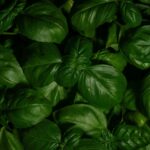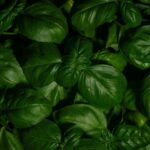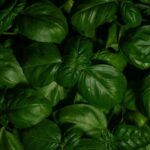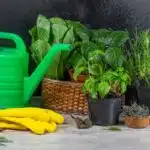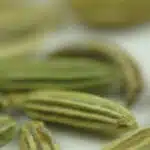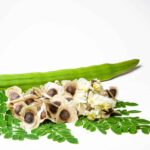Growing basil may sound impossible, but with the right knowledge and understanding of this fragrant herb you can become an expert in no time. With just a few steps and some patience, you can bring your garden or kitchen windowsill to life with aromatic basil that will make your meals taste like they were cooked by a master chef! Whether you’re an experienced gardener or just starting out, this article will provide all the information needed to turn you into a basil-growing guru.
Basil is one of the most versatile herbs around — it can be used to season savory dishes, dress up salads, or even add flavor to drinks. Plus, it’s easy to grow indoors or in your garden. All you need is some sunshine and water, and before long you’ll have lush green plants bursting with flavor. With this comprehensive guide on how to grow basil indoors and in your garden, you’ll soon be harvesting more than enough for every meal.
From learning how to select the right type of potting soil to knowing when it’s time to harvest, this article will teach you everything there is know about growing this delicious herb. Keep reading if you want learn how to turn your home into an aromatic paradise or your garden into an oasis filled with fresh herbs!
Choose A Variety Of Basil For Your Garden
Did you know that there are more than 60 varieties of basil? With so many choices, it can be tricky to decide which one to grow. When it comes to growing basil in your garden, the first step is to choose a variety.
If you’re looking for a classic flavor, sweet basil is the way to go. It’s also great for using in recipes like pesto and pasta sauces. For those who want something more unique-tasting, try Thai or lemon basil. Each variety has its own distinct flavor profile and aroma.
No matter which type of basil you select, it’s important to make sure it’s suited for your climate and soil conditions. Some require full sun while others prefer partial shade–it all depends on where you live and what type of environment you have in your garden or yard. Knowing this information ahead of time will help ensure success when growing basil!
Find The Right Location For Growing Basil
Not only is it important to choose a variety of basil for your garden, but it is also crucial to find the right location for growing it. When deciding where to plant your basil, it’s helpful to keep in mind the preferences of the herb and its environment. Surprisingly, there are more than 60 types of basil that can be grown indoors or outdoors, each with its own set of needs.
When deciding on a location outdoors, you should keep in mind that basil prefers full sun and moist soil. It’s best planted in well-drained soil enriched with plenty of organic matter; otherwise, it may become thirsty and need frequent watering. The ideal temperature range for growing basil is between 18-30°C (65-86°F). If these conditions cannot be met outside, consider growing it indoors instead.
Inside, you’ll want to place the plant near an east or west window as this will provide enough sunlight without subjecting it to too much heat. If your home doesn’t have large windows or enough natural light, consider investing in some grow lights for additional assistance. With the right combination of sun and water exposure, your indoor plants should stay healthy and happy year-round! Now that we’ve identified the perfect spot for our basil plants, let’s prepare the soil for growing them.
Prepare The Soil For Growing Basil
When it comes to growing basil, one of the most important factors is soil preparation. Before planting your basil, you’ll need to make sure that the soil has the necessary nutrients for a healthy crop. This can be done through adding compost or fertilizer to the soil. It’s also important to ensure that the soil is well-drained and aerated so that your basil can thrive.
In order to ensure optimal drainage, you may want to consider adding perlite or sand to the soil before planting. Additionally, you should check the pH levels of your soil in order to make sure they are within an acceptable range (6-7). If they are not, you may want to adjust them by adding lime or sulfur as needed.
Finally, you should loosen up the top 4-6 inches of the soil before planting your basil so that it can receive all of its essential nutrients and water evenly. With proper soil preparation and care, your basil plants will grow healthy and strong!
Plant Basil Seeds Or Transplants
Once you have your soil prepared, it’s time to plant your basil. You can either use seeds or transplants, depending on your preference and what’s available in your area. If using seeds, make sure they are fresh and of good quality. Plant them directly into the prepared soil and lightly cover with a thin layer of soil. Water gently and keep the soil damp until the seeds germinate. Transplants are a great option if you don’t want to wait for the seeds to grow. Simply dig a hole in the prepared soil about twice as wide as the root ball and just as deep. Place the transplant in the hole, backfill with soil, and pat down firmly around it.
Next up is watering and fertilizing your basil plant. To ensure healthy growth, regularly water your plant with plain water every couple of days or when the top inch of soil looks dry. Be careful not to overwater as it can lead to disease problems with basil plants. For best results, fertilizer should be applied about once a month during active growth periods such as spring and summer. Look for an organic fertilizer specifically designed for herbs like basil that will provide all essential nutrients without burning or damaging your plants.
Now that you’ve planted your basil in well-prepared soil, it’s time to maintain its health by providing adequate water and fertilization throughout its lifecycle!
Water And Fertilize Your Basil Plant
According to the National Gardening Association, nearly 75% of all households are home to at least one herb garden. With the right preparation and care, basil is a great herb for a home garden. This includes providing your plant with the proper water and fertilizer.
In order to give your basil plant the best chance of success in your garden, it’s important to provide it with enough water and nutrients. Watering is key; basil should be watered regularly but not too frequently so that the soil isn’t overly saturated. Consider giving your basil a weekly deep soaking if you’re having trouble remembering how often to water it. Additionally, an all-purpose fertilizer can help ensure your plant stays healthy and strong throughout its growth cycle.
Giving your basil plant proper hydration and nutrition will go a long way in helping it thrive in both indoor and outdoor gardens. By taking these steps, you’ll be able to enjoy delicious homegrown basil in no time! To take things further, you can also try growing basil in containers indoors – just make sure that you provide the same level of care as would with any other garden plants.
Grow Basil In Containers Indoors
Some may be hesitant to grow basil indoors, as they worry it is too difficult. However, with a few simple steps, growing basil in containers indoors can be a rewarding and relatively easy experience!
To begin, ensure that you have the right type of pot. The pot should have drainage holes at the bottom and should be made of either clay or plastic. Choose one that is slightly wider than it is tall and has plenty of room for your plant’s roots to spread out. Additionally, make sure you select soil specifically made for container gardening; normal garden soil won’t work here.
Next, place your potted basil in an area that gets a lot of direct sunlight, such as a windowsill or balcony. You’ll also need to water your plant regularly; check the soil daily to see if it needs more water by sticking your finger into the soil about two inches deep; if it’s dry, add some water. Fertilizing both indoor and outdoor plants once every two weeks helps them stay healthy and vibrant.
With these tips in mind, you can easily grow delicious basil in containers indoors. Now all you’ll need is to select the perfect pot for your basil plant!
How To Choose A Pot For Growing Basil
The pot is like a vessel, representing the potential for growth and nourishment of the basil. It’s an essential part of the process to ensure that the herb flourishes in its new home. When selecting a pot for basil, there are some key considerations that must be taken into account.
Size is an important factor when picking out a container for your basil. It should be large enough to provide adequate space for its roots to grow, ensuring that it has access to all the nutrients needed for proper growth. Additionally, make sure that there are several drainage holes in the bottom of the pot – these will help prevent waterlogging and root rot.
Aesthetics can also come into play when choosing a pot for growing basil. You may want to opt for something colorful or eye-catching that adds to your garden’s overall look and feel. However, don’t forget about practicality: make sure it is made from a durable material such as terracotta or ceramic that can withstand frequent watering and other elements of nature. With these tips in mind, you’ll be able to find just the right pot for your beloved herb!
Prepare The Potting Mix For Basil
Once you’ve chosen a pot for your basil, it’s time to prep the soil. A good potting mix for growing basil should be well-draining and nutrient-rich. To make sure your basil has the best possible conditions for growth, use a mix of one part potting soil and two parts perlite or vermiculite. You can also add in some compost or fertilizer to give the soil an extra boost of nutrients.
Before planting, it’s important to make sure your potting mix is properly aerated. If it’s too compacted, add some sand or coarse gravel to help break it up and improve its drainage capabilities. Once you’re satisfied with the consistency of the soil, moisten it using a spray bottle or watering can until it’s evenly damp but not saturated.
Now that your potting mix is ready, you can start sowing your basil seeds! Make sure to read any instructions on the packet before planting them – this will give you an idea of how deep they need to be buried and how much space they need between each seedling. With your potting mix prepped and your seeds nestled in securely, all that’s left to do is wait for them to sprout! After a few weeks of regular watering and plenty of sunshine, you’ll have a bountiful crop of fragrant herbs ready to enjoy.
Sow Basil Seeds In The Pot
Growing basil indoors and in the garden might seem like a daunting task. But, it’s all too easy if you know what to do, and that includes sowing the seeds in the pot! You’d be surprised how quickly your basil plants will grow once they’re potted.
Irony at its finest, planting something so little yet so powerful is actually quite simple. All you need to do is prepare a potting mix, add some water and fertilizer if needed, then carefully sow the basil seeds into the soil of your pot. It doesn’t take much effort, but it’s important to make sure they get enough sunlight and water.
Once your basil plants have been sown and nurtured, it’s time to care for them. Pruning them regularly can help promote healthy growth and ensure that the flavor remains strong for years to come. Plus, providing adequate nutrition with compost or fertilizer will go a long way in keeping your plants happy and healthy. With just some basic care and attention, you’ll soon be enjoying fresh basil from your own garden or indoors!
Care For Basil Plants Indoors
Caring for basil is the key to producing fragrant, flavorful leaves. Much like tending a garden of beloved friends, we must provide our basil plants with the right conditions and attention to help them thrive. Allusion aside, this step in growing basil is essential for any successful indoor or outdoor harvest.
First, it’s important to make sure your basil has enough light. Basil loves full sun and can tolerate partial shade; however, too much shade will result in spindly plants with few leaves. If you are growing indoors, place your pots near a sunny window where they will get at least six hours of direct sunlight each day. If you’re growing outdoors, position your pots in an area that gets at least six hours of direct sunlight each day.
In addition to providing plenty of light, basil also needs well-drained soil and regular waterings. Water your plants when the top two inches of soil feel dry to the touch—about once per week depending on the temperature and humidity levels in your home or garden. Make sure not to overwater as this can cause root rot and other issues for your plants. Finally, make sure to fertilize your basil every two weeks with a balanced fertilizer diluted according to package instructions for best results.
By providing adequate light, water and fertilizer, you’ll be well on your way towards cultivating a healthy crop of fragrant basil leaves—ready to harvest and store as needed!
Harvest And Store Basil
Basil is known as the king of herbs, used to flavor many dishes around the world. It’s no wonder that so many are trying to grow it in their garden and indoors. But what happens when it’s time to harvest? How can you make sure your basil stays fresh and flavorful?
Harvesting basil is a special task that requires careful attention and timing. If you harvest too soon, the leaves may not have reached their full flavor potential. On the other hand, if you wait too long, they may become too mature and woody. To get the best results, use sharp scissors or pruning shears to clip off stems with two to three sets of leaves at a time. This will allow new growth to continue while also providing ample yields for cooking.
Once harvested, basil should be stored correctly so it retains its freshness for longer periods of time. To do this, wrap the stems in damp paper towels or cloth and place them in a plastic bag with holes or wrap them in wet newspaper before storing them in the refrigerator. This will ensure that your basil stays crisp and flavorful for up to a week after harvesting! With proper harvesting and storage tactics, you’ll be able to enjoy fresh basil year-round – both indoors and outdoors! Now let’s move on to common pests and diseases of basil…
Common Pests And Diseases Of Basil
When it comes to pests and diseases, basil is a real drama queen! She needs all the attention, with her constant outbursts of mildew and aphids that threaten to ruin her beauty. But don’t worry – there are ways we can help our beloved herb. Let’s take a look at the common pests and diseases of basil.
Basil is susceptible to fungal diseases such as powdery mildew, downy mildew, and root rot. To prevent these issues, make sure your plant has good air circulation and plenty of sunlight. Additionally, avoid overhead watering which can increase humidity levels around the plant. If you do find signs of disease on your basil, remove any affected leaves promptly to reduce further spread of the infection.
Aphids are another common pest that love feasting on basil leaves. If you notice small green or black insects on the underside of your leaves or clusters of white eggs on the stems or branches, it’s likely an aphid infestation. The best way to get rid of these pesky critters is to spray them off with water or treat them with insecticidal soap or neem oil if needed.
Now that we’ve gone over some common pests and diseases for growing basil indoors and in your garden, let’s move onto some tips for growing basil in hot climates…
Tips For Growing Basil In Hot Climates
It is often assumed that growing basil in hot climates is difficult, but this is not necessarily the case. In fact, with the right knowledge and tips, one can have a flourishing basil plant even in warm environments. This article will discuss some of the best strategies to ensure success when growing basil in hot climates.
First and foremost, it is important to ensure that your basil plants get enough water, especially during the hottest days of summer. While you should generally avoid overwatering your plants, it is essential to make sure that they are not left without any moisture for prolonged periods of time. Additionally, be sure to use soil that drains well and avoid planting in areas that are prone to standing water or flooding.
When it comes to positioning your basil plants in hot climates, it is best to give them as much shade as possible. This can be accomplished by planting them near larger shrubs or trees or using some kind of cover such as a large umbrella or tarp. Furthermore, try to choose varieties of basil that do well in hot temperatures such as Thai Basil or African Blue Basil. With these simple steps you can successfully enjoy a bountiful harvest of flavorful herbs even under scorching sun rays!
Companion Planting With Basil
Companion planting with basil is a great way to ensure your herb garden thrives. This practice of planting two or more different species of plants together can be beneficial for both. Basil has many companion plants, such as tomatoes, parsley, and onions. Each of these provide something that the basil needs in order to grow healthy and strong. When planted together, the other plants will help protect the basil from pests and diseases, as well as promote better growth by providing essential nutrients.
When adding companion plants to your basil garden, it’s important to consider the size and space needed for each plant. Tomatoes are particularly popular companions for basil and they require quite a bit of room to thrive. On the other hand, parsley is a smaller plant that doesn’t need nearly as much space and can even be grown in containers if desired. Before purchasing any new plants for your garden, make sure you have enough space so all plants can grow properly without crowding each other out.
By combining companion planting with proper care and maintenance, you’ll be able to enjoy an abundant harvest of fresh herbs each season! With this method in place, you’ll be able to produce lush foliage without having to use any harsh pesticides or fertilizers. Now that we’ve discussed how to grow basil indoors and in your garden with companion planting, let’s move on to how best to use fresh basil when it’s time for harvesting!
How To Use Fresh Basil
Beginning with a flourish, planting basil is a delicious way to bring life and flavor to any garden or kitchen. Not only does it add a zesty aroma and taste to dishes, but its presence in the garden can also attract beneficial insects. And once you know how to use fresh basil correctly, you’ll be able to reap the benefits of this amazing herb for years to come.
Now that you’ve got your basil seedlings growing nicely indoors or out, it’s time to figure out how best to use them. Fresh basil is great for adding flavor and aroma to salads, soups, pasta dishes, pesto sauces—the list goes on! It pairs well with other herbs like oregano, thyme, sage and rosemary; as well as vegetables like tomatoes and peppers; and fruits such as peaches and apricots. For maximum flavor impact when cooking with fresh basil, add it at the end of the dish’s preparation so that it will retain its vibrant color and fragrance. As an added bonus, if you have extra leaves after using them for cooking purposes, you can dry them for future use in tea or seasoning mixes.
When using fresh basil in its raw form as a garnish or salad topping, remember not to over-handle it; this will cause it to lose its natural oils which give off its distinctive aromas. Instead, tear the leaves into small pieces just before serving so they retain their unique flavors and fragrances until they reach your plate. With simple steps like these in mind, you can enjoy all the taste sensations of this wonderful herb at home!
Frequently Asked Questions
How Long Does It Take For Basil Seeds To Germinate?
The promise of fragrant herbs just waiting to be harvested is enough to make any gardener’s mouth water. Basil, in particular, is a simple and versatile herb that lends its unique flavor to many dishes. But if you’re wondering how long it takes for the seeds to germinate and start sprouting, you’ll be pleased to learn that the answer is surprisingly fast.
It usually only takes about five to ten days for basil seeds to germinate, with some varieties sprouting even sooner. The key is providing plenty of moisture and warmth – both essential for great growth. Of course, like all plants, there are many factors that can delay the process, such as soil quality and temperature. But once the seedlings do appear, they’ll grow quickly in a healthy environment.
Basil plants mature quickly and reward gardeners with an abundance of flavorful leaves in no time at all. Like so many gifts from nature, it’s amazing how something seemingly so small can yield so much deliciousness — it truly is a miracle of sorts!
How Often Should Basil Plants Be Watered?
We’ve all been there, staring at a pack of basil seeds and wondering how often to water them. Thankfully, the answer is not as daunting as it may seem. By following a few simple rules you can have your very own thriving basil plants in no time.
To get started, keep in mind that the key to successfully growing basil indoors or outdoors is to ensure the soil has adequate moisture at all times. Don’t be tempted to drown your plants – water them lightly but frequently for best results. In fact, an anachronism here: think of it like giving your basil plants a light sprinkle instead of a soaking every day!
The frequency of watering also depends on factors such as temperature, humidity and even wind speed – however, generally speaking, you’ll want to make sure your basil plants are getting watered at least twice a week if they’re kept indoors and once or twice more each week if they’re grown in an outdoor garden bed. Just make sure you don’t overwater; try holding off on extra watering until the top layer of soil feels dry when touched.
By following these guidelines and paying closer attention to the needs of your basil plants, you should soon have flavorful greens flourishing from your garden or windowsill!
How Can I Protect My Basil Plants From Pests?
Protecting basil plants from pests is an important part of successfully growing and harvesting them. Pests can cause significant damage to basil leaves and stems, so it’s essential to take preventive measures to keep them at bay. The good news is there are several simple steps you can take to safeguard your basil plants against pests.
One of the most effective ways to protect your basil plants from pests is to introduce beneficial insects into the garden. These bugs will help control the pest population by eating their eggs and larvae. Additionally, companion planting can be an effective pest-control measure; growing marigolds, nasturtiums, and garlic near your basil will ward off unwanted critters. Finally, regular inspection of your basil plants and removal of any damaged or diseased foliage can help prevent pests from taking hold in the first place.
It’s also important to remember that proper watering habits can play a role in protecting basil plants from pests. Keeping soil moist but not overly saturated will discourage some types of insects while encouraging beneficial ones like ladybugs and ground beetles that feed on problem pest species. Therefore, it’s important to pay attention to water levels when caring for your basil plants!
How Long Will Basil Plants Last Indoors?
As the saying goes, “good things come to those who wait” – and that is certainly true when it comes to growing basil indoors. While the process of cultivating a successful indoor basil plant can seem daunting at first, with patience, effort and the right knowledge, you will be rewarded with a delicious and aromatic herb to enjoy in your cooking.
So how long will basil plants last indoors? Generally speaking, you can expect an indoor basil plant to survive for up to three months before needing to be replaced. Of course, this is dependent on many factors such as temperature and sunlight, so if you can create ideal conditions for your plants then they may even last longer. Regularly pruning your basil plants is also essential for ensuring their health and longevity.
With proper care, an indoor basil plant will provide you with fresh herbs for a few months at least – giving you plenty of time to experiment with different flavours in your culinary creations!
What Is The Best Way To Store Fresh Basil?
The smell of fresh basil is like a breath of summer in the middle of winter. Its sweet, fragrant aroma has tantalized the taste buds of cooks for centuries and continues to do so today. But even if you can’t grow it outdoors in your garden, there is still a way to keep that unique flavor around all year long: by learning how to store fresh basil properly.
Fresh basil needs to be stored differently than other herbs. The best way is to wash the leaves, blot them dry with a paper towel, then place them into a zip-top plastic bag with some air left inside. This will help preserve their moisture and flavor. If you plan on using the leaves within two or three days, then you can also wrap them in damp paper towels before storing them in the fridge – this method prevents wilting and keeps the leaves from drying out too quickly.
For longer-term storage, freeze the basil leaves after washing and drying them thoroughly. You can either place them in an airtight container or freezer bag for up to six months or make pesto sauce and store it for up to one year. Either way, you’ll have preserved that delicious flavor so you can enjoy it any time of year!
Conclusion
As you can see from this article, growing basil indoors and in the garden is a simple but enjoyable task that anyone can do. While it takes some time to germinate the basil seeds and protect them from pests, with a little patience it’s possible to enjoy fresh basil for weeks or even months.
What’s more, harvesting the herb allows you to preserve its flavor and use it in your cooking. The sweet smell of basil fills the air as you pluck each leaf, evoking happy memories of sunny days spent in the garden.
Storing fresh basil also means that you can keep enjoying its flavor all year round. With just a few simple steps, anyone can grow their own delicious basil – both indoors and out! So why not give it a try – you won’t be disappointed!


